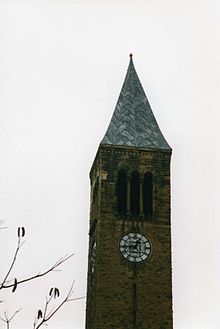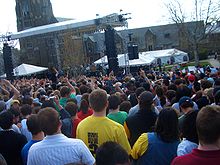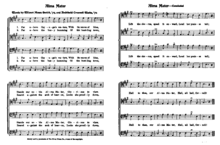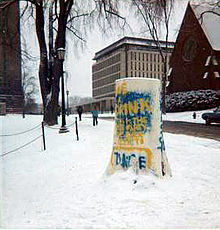- Cornelliana
-
Cornelliana is a broad term that can refer to anything related to Cornell University's unique traditions, legends, and lore.
Contents
Traditions
Dragon Day
Main article: Dragon DayDragon Day is an annual celebration that began in 1901, known as "College of Architecture Day", and occurs, traditionally, on the Thursday before St Patrick's Day. The central event is the burning of a dragon designed and built by Architecture first years at the hands of the oldest fifth year Architecture student, with the help of the Ithaca Fire Department, on the Arts Quad. [1] As of 2009, burning the Dragon itself is no longer permitted.[2]
Impromptu Student Activities
While Cornell students are no stranger to such activities as streaking, screaming before finals, or flash mobs[3], other impromptu activities are more specific to Cornell and its unique terrain:
Traying down Libe Slope After a fresh snow fall, undergraduates have been known to smuggle trays from the dining options in Willard Straight Hall or from the dormitory dining halls and use them to sled down Cornell's dramatic Libe Slope, a 100 foot hill stretching from Cornell West Campus to Uris Library, the undergraduate home of the Cornell University Library.[4] Due to the safety hazards associated with sledding down the Slope - which has patches of trees on it - at such high speeds, the administration has published warnings outlawing this tradition, yet it persists.
Gorgeing Over the summer, and at the beginning and end of the academic year when Ithaca enjoys warmer weather, students are known to find respite from the heat in the two creeks that cut across Cornell's campus through two dramatic gorges -- Cascadilla and Fall Creek. While the activity is illegal due to safety concerns, and several students have drowned while "enjoying" the gorges, it does not deter students from swimming in the various swimming holes, playing in the waterfalls, or jumping off of 'Lover's Leap' north of Beebe Lake into the pool of water thirty feet below. [4]
Slope Day
Main article: Slope DaySlope Day is an annual day of celebration, held on the last full day of classes (usually the first Friday of May). Though Slope Day has gone through many reincarnations since its inception in 1901, in recent years focus has shifted to live musical performances open to the Cornell community and a select number of guests. Students gather on Libe Slope to enjoy the music and party. Recent performers include Ben Folds, Snoop Dogg, Kanye West, The Game, O.A.R., Dilated Peoples, Rusted Root, Fat Joe, TV on the Radio, and T.I.. Slope Day is often criticized for the excessive drinking that many students participate in before, during, and after the scheduled events.[5] In recent years, Slope Day has become more regulated, in an effort to stop underage drinking on the Slope. In order to regulate it, the Slope itself has been fenced off and entrances have been placed for ID checks.
Hot Truck and Louie's Lunch
Generations of Cornellians have had their late night food cravings satisfied by the two legendary food trucks, the Hot Truck and Louie's Lunch. Louie's Lunch, or just "Louie's", was created in 1916 by Greek immigrant Louis Zounakos.[6] Its original incarnation was a food cart that he pushed around campus, which he soon replaced with a Ford truck.[6] In the late 1940s, Louie bought the custom made red and white truck that Louie's has been run out of to this day across the street from Risley Hall, and just steps from the Zeta Psi Fraternity.[6] Between 1962 and 1981, Louie's Lunch was located on West Campus and renamed "The Cold Truck", because it only sold cold foods such as coldcuts.[7]
Below West Campus sits Louie's rival since 1960, "The Hot Truck". The name came from owner Bob Petrillose's desire to differentiate himself from the cold truck. [7] Unlike Louie's which serves a wide variety of edibles, The Hot Truck sells just one item: pizza subs. Petrillose determined soon after opening that he could cut costs by only selling pizza. Bob discovered that he could produce a superior pizza when he put the toppings on buttered French bread. He dubbed his creation the PMP (or "Poor Man's Pizza"), which has since been brought to national popularity by Stouffer's.[8] Over the years, the variety of pizzas has expanded with complete dictionary of combinations (of varying peculiarity) created by students, such as the "North Baker", which has garlic, mozzarella, pizza sauce, mustard, lettuce, and sour cream & onion potato chips. The Hot Truck is now owned by Shortstop Deli, which also serves its subs. [9] The Legendary Hot Truck founder Bob Petrillose died on December 8, 2008 (http://today.14850.com/1209bobpetrillose.html). [10]
Athletic Traditions
As the most popular sport on campus, many of Cornell's athletic traditions revolve around the Men's Ice Hockey Team, and their fans, the Lynah Faithful. These include the famous Cornell-Harvard Hockey Rivalry, often considered one of the finest rivalries in collegiate hockey, which annually features fish being thrown at Harvard hockey players when they take to the ice at Lynah Rink, Cornell students and alumni turning the Bright Hockey Center in Allston, MA into "Lynah East" once a year. Win, lose, or tie, the hockey team in Carnelian and White salutes the Faithful at the end of every home game before leaving the ice.[11]
The Cornell Big Red Pep Band leads the Faithful through a rendition of the Alma Mater at every hockey game. Thanks to this tradition, Cornellians tend to know the words to their song more so than many other schools. Additionally, on the night of the last home hockey game of the year, all six verses of the song are sung by students.
Outside of hockey, other traditions abound throughout Cornell Athletics. Every year, the football team squares off against the men from the University of Pennsylvania in the battle for the Trustee's Cup. At Schoellkopf Field, freshmen have traditionally taken the field by storm for the first home game of the year, while seniors take the field for the final home game of the year. Many traditions are passed down through the Cornell Big Red Marching Band (the only real marching band in the Ivy League), including the annual concert within Cornell's undergraduate library, Uris Library, the morning of the last home game of the year.
Student Requirements
New Student Reading Project
A recently begun Cornell tradition is the New Student Reading Project or sometimes called Freshmen Reading Project. Begun for the Class of 2005, all incoming freshmen and transfer students are required to read a book chosen by the university. Alumni and faculty are encouraged to also read the book. When students arrive, they participate in discussion groups and other activities related to the book. For example, in the Fall of 2005, Chinua Achebe came to Cornell and discussed his Things Fall Apart ('09). Other books have been Guns, Germs, and Steel ('05), Frankenstein ('06), Antigone ('07), The Trial ('08), The Great Gatsby ('10), The Pickup ('11)[12][13], Lincoln at Gettysburg ('12) [14], The Grapes of Wrath ('13)[15], Do Androids Dream of Electric Sheep? ('14), and Homer & Langley ('15)[16]
Swim test
In 1918, at the urging of the Director of Women's Physical Education, Cornell began requiring that all female students must pass a swim test before graduating. In 1937, the school expanded the swim test requirement to all undergraduates. Despite reviews of this policy over the years, all students—with the exception of transfer students—must pass a swim test. The original swim test was administered as two-laps in the Old Armory Pool, which was half Olympic length. When the men's swim test was transferred to the Teagle Hall pool, the distance was preserved. When the women's swim test was transferred to the Olympic length pool in Helen Newman Hall in 1963, the number of laps was preserved. This disparity continued until 1970, when Trustee Robert Platt raised the issue of why women were required to swim twice as far as men to pass the test. Students who fail or do not take the swim test are enrolled in an introductory swimming course. Colleges and universities with similar swimming requirements include Dartmouth College, Columbia University, Bryn Mawr, the University of Chicago, Notre Dame, MIT, Hamilton, Swarthmore, and Washington & Lee, and the service academies. [17]
Cornell Songs
Like many colleges in the United States, Cornell has a number of traditional songs associated with the Cornell University Glee Club and Cornell Big Red Marching Band, from fight songs to the alma mater. See List of Cornell Songs for a partial list.
"Far Above Cayuga's Waters"
Main article: Far Above Cayuga's Waters"Far Above Cayuga's Waters" is Cornell's alma mater. The lyrics were composed in 1870 by two roommates to the tune of "Annie Lisle", a popular ballad of the day. The song is considered to be one of the best known alma maters in the world as it has been adapted and adopted by numerous universities, colleges, and high schools both in the United States and the world. The song traditionally concludes campus concerts by the Cornell University Glee Club and Chorus.[18]
"Give My Regards to Davy"
Main article: Give My Regards to Davy"Give My Regards to Davy" is Cornell's primary fight song. It was written in 1904 by three roommates at Beta Theta Pi to the tune of George M. Cohan's "Give My Regards to Broadway". Cornellians sing this song at sporting events, especially hockey.
"We Didn't Go To Harvard"
Sung by Cayuga's Waiters to the tune of Billy Joel's We Didn't Start the Fire, it is one of the best known and popular a cappella songs in the Ivy League, and makes light of Cornell's reputation as a "safety school" for Harvard applicants. The song features a rotating cast of verses that document the contemporary Cornell student experience. [19]
Legends
Arts Quad statues
On the Arts Quad exist two statues memorializing the founders of Cornell, Ezra Cornell and Andrew Dickson White. According to legend, if a virgin crosses the Quad at midnight while the chimes are ringing, the two statues will walk off their pedestals, meet in the center of the Quad, and shake hands on the chastity of the university. (Variants of this legend have it that they will take each other's place, or they will dance a jig to celebrate the student's purity.) To this day, the statues have never switched places, shaken hands, or danced; Cornell's tour guides maintain this is because the bells do not ring at midnight. Every year since 1936, Phi Sigma Kappa has repainted footprints on the Quad to memorialize the legend.[20]
Ghosts
The widow of Willard Straight made several reportedly unsuccessful attempts to contact her late husband through mediums. Hiram Corson (1828-1911), a Professor of Anglo-Saxon Literature, was purported to have had posthumous conversations with Robert Browning and Henry Wadsworth Longfellow. On a more permanent basis, ghosts are said to haunt several buildings on the Cornell campus.
In Risley Hall, the namesake of the dormitory, Prudence Risley, flits about the building, flickering the lights. During its days as the Residential Club, Ecology House suffered a fatal fire, whose victims are credited for strange lights and voices.[21] Some say that the Statler Hotel is haunted by the building's namesake, Alice Statler; other buildings said to be haunted include the Undergraduate Admissions Office, McGraw Tower, and the Delta Kappa Epsilon, Sigma Chi and Lambda Chi Alpha fraternity houses among others.[21]
If a bride is married in Sage Chapel, she will probably use the crypt to prepare as no other appropriate room exists. Within that crypt are buried the founders and numerous other important contributors of the University. If the bride waits long enough, it is said the spirits may rise to bless the marriage.[22]
Hoy Field
Main article: Hoy FieldOne campus legend says that the first person to hit a home run out of Cornell's baseball field was former U.S. president George H.W. Bush while he was a student at Yale University.[23] Though Bush did play at Hoy Field, this legend is not true. The first player to hit an outside-the-park home run was a student at Syracuse University. Interestingly, however, the second person to achieve this feat was Columbia University student and future baseball hall-of-famer Lou Gehrig on April 21, 1923.[23]
Relationships
Many Cornell legends relate to relationships. One says that if a student refuses a kiss on the suspension bridge that stretches across Fall Creek next to the Johnson Museum of Art, the bridge will collapse into the gorge.[24][25] Another legend says that if a couple walks around the entire perimeter of Beebe Lake while holding hands, the two are destined to be engaged. Yet another legend says that about 60% of Cornell students marry other Cornellians. In reality, the number is closer to 8%.[26]
Lore
Campbell Soup
Campbell Soup cans' colors are red and white. Cornell's colors are red (carnelian, specifically) and white. The similar colors are no coincidence. In 1898, Herberton Williams, a Campbell's executive, convinced the company to adopt a red and white color scheme, because he was taken by the crisp colors of the Cornell University football team's uniforms. In 2004, at the urging of The Image Committee of the Student Assembly, Cornell University officially reverted to a version of this shade of red (PMS 187) after a four-year brush with the much brighter PMS 186.[citation needed]
Items atop the clocktower
 A pumpkin atop the clocktower
A pumpkin atop the clocktower
At least two times, students have placed items atop the clocktower secretly in the middle of the night. In October 1997, a pumpkin was found on top of the clocktower. It remained there until it was removed in March of the following year. It was found to have been cored, which accounted for its longevity. It has since been memorialized as an ice cream flavor, "Clocktower Pumpkin", produced by the Cornell Dairy. A piece of the pumpkin is stored in the Wilder Brain Collection. In April 2005, a disco ball was found tied onto the clocktower with climbing rope. According to the Cornell Police, someone gained access to the top of the clocktower by breaking a sealed hatch on the clocktower and then free-climbing up the roof.[27]
Gettysburg Address
President Lincoln, in April 1864 — at the request of George Bancroft, a historian, wrote out a manuscript of the Gettysburg Address. Mr. Bancroft planned to include this copy in "Autograph Leaves of Our Country's Authors," which he planned to sell at a Soldiers' and Sailors' Sanitary Fair in Baltimore. As this copy was written on both sides of the paper, it proved unusable for this purpose, and Mr. Bancroft was allowed to keep it. This manuscript is the only one accompanied by a letter from Lincoln transmitting the manuscript and by the original envelope addressed and franked (i.e. signed for free postage) by Lincoln. This copy remained in the Bancroft family for many years until it was donated to the Carl A. Kroch Library at Cornell University by Nicholas H. Noyes and can be viewed by anyone who asks.[28] Out of five known manuscripts, Cornell's copy holds the distinction of being the only one owned by a private institution. Among historians, Cornell's manuscript is known as the Bancroft Copy.[28]
Hugo N. Frye
In 1930, Republican leaders across the United States received letters inviting them to a celebration in Ithaca to celebrate the 150th birthday of Hugo N. Frye, the founder of the New York Republican Party and coiner of the immortal phrase "Freedom in the land of the free." Many leaders sent replies lauding the great work done by Frye, which were read at the celebration. Much to their embarrassment, a New York Times reporter got a hold of this story and discovered that Frye was the creation of Lester Blumner and Edward Horn, two editors for the Cornell Daily Sun.[29]
Stump
In the 1960s, Dutch Elm Disease finally killed all the elms on Cornell's campus. In 1969, the grounds crew left one six foot tall stump in front of Willard Straight Hall to be a lasting reminder of the elms, affectionately known to Cornellians as the Stump. For a decade, students used the stump as a combination soapbox/message board, delivering speeches from atop the piece of wood and tacking posters to its sides. In 1975, a student group sawed down the stump in the middle of the night and ransomed it for charity. Unfortunately, though the grounds crew reattached the stump, vandals knocked it over again. The stump stayed down, never again to be raised.[citation needed] Today, the stump is memorialized with a plaque at the tree's original location.
Secret societies
See also: Quill and DaggerSee also: Sphinx HeadMyriad secret societies flourished on Cornell University's campus from its founding until the 1960s. These societies included Cornell's first fraternities and sororities, class honor societies, and drinking societies. As students rebelled against "elitism" and "The Establishment" during the 1960s, many of Cornell's drinking societies and honor societies became inactive or disappeared. Of the numerous class societies active in the early 20th century, two remaining secret senior honorary societies, Quill and Dagger and Sphinx Head, are the most well-known. Membership is mutually exclusive between the organizations.[citation needed]
Freshman ('Piker') beanies
In the first part of the 20th Century, male freshman at Cornell were referred to as 'pikers'[30], and required to follow eleven strict rules published in the freshman handbook. These ranged from "No smoking on campus" to "Give your trolley seat to an upperclassman." Number four on that list was "Wear your cap." The cap was a red beanie with a gray button on top. Freshmen boys wore their hats until the annual spring beanie burning. This rule was taken very seriously. One student, Frederick Morelli 1924, was chained to a tree for two hours and dunked in the lake for refusing to wear his cap, thus earning Cornell the name "Lynch College". By the 1960s, this tradition had disappeared.[31]
The White library bell
When Andrew Dickson White returned to the United States in 1894 from his post as the minister to Russia, he brought back a 361 pound church bell. For many years, janitors rang the bell to warn students of the library's nightly closing. Due to complaints about the "booming resonance" of the bell, librarians began ringing a smaller bell to warn of White's bell.[32] Today, White's bell is stored in the Andrew Dickson White Reading Room in Uris Library.[33]
Zinck's Night
Theodore Zinck was a saloonkeeper in Ithaca, and his pub, the Hotel Brunswick, was a popular gathering place for Cornellians in the 1890s. After his death in 1903, several bars using his name (Zinck's) continued to provide a haven for students. When the last Zinck's closed in the mid-1960s, celebrating the spirit of Zinck's became a favorite Thursday night Collegetown tradition for undergraduates. To this day, Cornell alumni around the world celebrate Zinck's night once a year, on a Thursday in October.
Zinck's is immortalized in the Cornell fight song Give My Regards to Davy, with the following line:
We'll all have drinks at Theodore Zinck's, When I get back next fall!
References
- ^ alumni . cornell facts | Dragon Day
- ^ Beast Escapes the Fire in Annual Dragon Day Festivities
- ^ A Video of Cornell Students Acting Like Idiots > Cornell, flashmob, YouTube | IvyGate
- ^ a b Dear Uncle Ezra - Questions for Thursday, September 29, 1994 - Cornell University
- ^ alumni . cornell facts | Slope Day
- ^ a b c http://www.louieslunch.com/history.htm, "Louie's Lunch", checked 1/19/07
- ^ a b http://cornellsun.com/node/569, "The End of an Era?", Cornell Daily Sun, September 12, 2000
- ^ http://www.news.cornell.edu/chronicle/99/8.26.99/hot_truck.html, "Alums hope Hot Truck's subs become a national obsession", Cornell University News Service, checked 1/19/07
- ^ Home Page
- ^ Home Page
- ^ The Harvard Crimson :: Magazine :: Rah, Rah, Rah, Rah, Who Cares?
- ^ Cornell University 2007 New Student Reading Project
- ^ 2007 reading project book selection
- ^ 'Lincoln at Gettysburg' selected for the 2008-09 New Student Reading Project
- ^ Reading Project of a Recession Year
- ^ 'Homer & Langley' chosen for New Student Reading Project
- ^ "?". The Chicago Tribune. http://www.chicagotribune.com/news/nationworld/chi-swimdec04,1,2567603.story?ctrack=1&cset=true.
- ^ Cornell University Glee Club
- ^ We Didn't Go to Harvard@Everything2.com
- ^ http://ezra.cornell.edu/posting.php?timestamp=561873600, "Dear Uncle Ezra - Questions for Thursday, October 22, 1987 - Cornell University" , checked 1/20/2007
- ^ a b http://cornellsun.com/node/19168 , "Ghosts, Ghouls, and Gorges", Cornell Daily Sun, 10/25/06
- ^ CAM Cornelliana
- ^ a b U.S. presidents visit Cornell
- ^ http://www.cornell.edu/tours/tidbit_template0c71.html, "Explore Cornell - Panos - Fall Creek", checked 1/19/07
- ^ "Fall Creek Gorge: Suspension Bridge Virtual Tour". Cornell University. http://www.fs.cornell.edu/tours/default.cfm?tour_id=41. Retrieved 2010-09-18.
- ^ Dear Uncle Ezra - Questions for Thursday, March 20, 2003 - Cornell University
- ^ Pumpkin Tale
- ^ a b The Gettysburg Address
- ^ Hugo N. Frye, Museum of Hoaxes, accessed April 2, 2008.
- ^ Dear Uncle Ezra - Questions for Thursday, October 26, 2006 - Cornell University
- ^ Tales of Cornell Freshmen | The Cornell Daily Sun
- ^ Uris Library Traditions
- ^ White Autobiography of Andrew Dickson White, Volume 2 - Chapter LV
External links
Categories:- Cornell University
- Traditions by university or college in the United States
Wikimedia Foundation. 2010.






